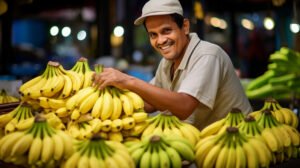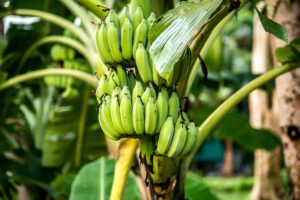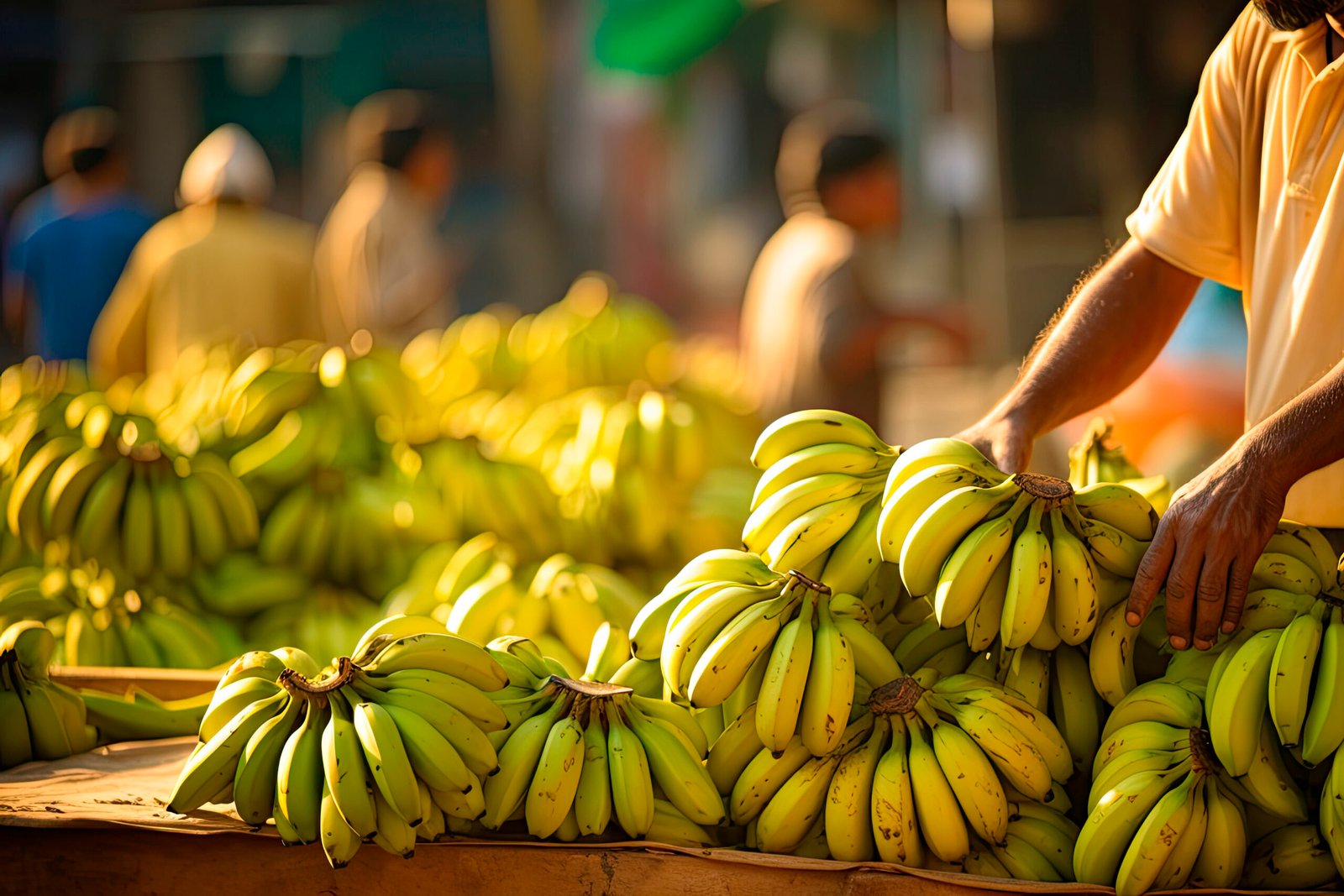Bananas are a tropical fruit, sweet and nutritious. They are elongated, curved and yellow when ripened. First, the skin will be speckled with dark spots and it shows its perfect for eating.
They also contain fibers, potassium, vitamin C and B6. They are an excellent fruit source for lowering the calories, digestive health and heart health maintenance as well boosting mood. Everyone eats bananas raw, but they are also suitable for smoothies or baked goods and other recipes.

Here’s a closer look at the advantages of consuming bananas:
Rich Nutrient Profile:
Nutrients: Certain nutrients are present in bananas including vitamins, especially vitamin C and vitamin B6. Vitamins such as Vitamin C that supports healthy immune function and skin, or B6, which is integral to brain development and functioning.
Potassium is a vital mineral, helping to balance fluids and manage blood pressure while supporting proper muscle and nerve function. They also have magnesium which helps us with muscle function, bone health.
Digestive Health:
Fiber: Bananas contain a good amount of dietary fiber, both soluble and insoluble. Pectin, or soluble fiber helps to stabilize blood sugar and can help reduce cholesterol levels. It softens your stool and helps it to move smoothly through the colon — So insoluble fiber eases constipation!!
Energy Boost:
Bananas supply natural sugars: Bananas include the organic sweeteners, fructose, glucose and sucrose. This makes them great pre-post workout snacks.
Antioxidant Properties:
Phytochemicals — Bananas contain dopamine and catechins, antioxidants that help combat free radicals in the body. This compound can drastically fight oxidative stress and inflammation which reduces the risk factor for chronic diseases.
Heart Health:
Potassium: Bananas are high in potassium, the mineral essential for blood pressure regulation and cardiovascular health. Eating enough potassium is linked to a lower risk of stroke and heart disease.
Mood and Sleep:
Tryptophan: Bananas lead to our daily supply of tryptophan, an amino acid that the body switches over into serotonin as well as melatonin. These neurotransmitters contribute to mood stability and good sleep.
How to Use Banana Fruit

Eat bananas: You can eat bananas as they are, fresh! You can simply consume them as snacks, or add to breakfast foods such cereal, yogurt and smoothies.
Smoothies: Bananas can be used to create a nutrient-packed smoothie when blended with fruits, veggies or protein such as Greek yogurt and milk.
Baking: Substitute mashed banana in baking recipes for natural sweetness and moisture. Then who can forget banana bread, muffins or my personal favorite- pancakes.
Frozen goodies: Ices for bananas, blend them with each other to provide a frozen treat power–you’ll be minted by the banana-farms-product of your lactose-cost-free soft ice cream per se. You can also add them to smoothies for an extra- creamy texture.
Salads — Slice bananas and throw them in with other tropical fruits to make a quick fruit salad, or add some fresh sliced banana atop your garden salads for both great flavor.
Where are banana trees grown and popular Banana producing countries?
Where Banana Trees Grow
Nowadays, banana trees are found in most tropical and subtropical locations throughout the world. They need for there to be warm temperature levels, high humidity and also a great deal of rainwater in order that they can easily grow adequately. Key requirements for banana farming
Climate: Bananas thrive in ranges of 60°F to 85°F (15°C -30°C) The need to be kept warm all the time because cold temperatures of 50°F (10°C) or lower can slow down growth and injure your plants.
Rainfall: Bananas require large amounts of water with preferably an annual rainfall range between 40 and 100 inches (1,000 to 2,500 mm). Irrigation may occur in areas where there is less rainfall to aid in growth.
Soil: You need well-drained, fertile soils to keep your banana tree healthy. They love a nice, loose loamy or sandy soil and prefer the pH between 5.5 to 7. One common issue is the development of root rot in heavy clay soils.
Sunlight Bananas need full sunlight to grow well. To keep the fruit production in check, they require a minimum of six-hours direct sunlight daily.
Countries that You all knew Produces Banana
While bananas are grown in a large number of countries around the world, there are some regions which stand out for their banana production. Some banana-producing countries include the following:
India:
India grows more bananas than anywhere else in the world. The banana is grown in different parts of the country thanks to the varied climate, we have it growing from states like Maharashtra to Tamil Nadu and Andhra Pradesh up-to Karnataka.
Types: India has numerous kinds of bananas, for example the celebrated Cavendish just as local ones like Nendran and Poovan.
Ecuador:
And as an overview, Ecuador is among the world’s most important banana exporting countries with one of its largest production areas where bananas are grown. Its warm climate and fertile soil are suited to extensive plantations of bananas.
Types: Most export bananas are Cavendish grown in only few varieties (Ecuadorocco)

Philippines:
The Philippines is also another big banana producer relatively to the world, and it exports them. The banana is grown on extensive plantations due to the tropical climate and fertile soil of that country.
Types: Cavendish, lakatan and saba (the Philippines has a lot of varieties being placed)
Brazil:
Description: Brazil is the largest banana producer in South America. Also known for banana cultivation is the country’s regions, tropical — Brazilian states of São Paulo, Bahia and Pará.
Varieties: Brazil grows all dessert bananas, but also cooks fruit.
Colombia:
Background: Colombia plays an important role in the banana trade, with most of its shipments going to the U.S. and European markets. This was perfect for banana farming due to the county’s climate.
There are also other varieties grown here, but Cavendish is the most common variety you will find in a shop List of Colombian banana farms TypesVarieties: Also known as Colombia (shipping name)Colombian.
Costa Rica:
Costa Rica is an important supplier of bananas, with most production taking place on large plantations located in the Caribbean region.
Types: As with other major exporters, Costa Rica plants Cavendish bananas for export.
Thailand:
Nutshell: Although Thailand is a banana producing country, this production significantly spread to almost all regions of the country.
Cultivar: Thailand produces many types of bananas, but the most well-known being Namwa and Kluai.
Uganda:
UgandaOverview: Uganda is the largest banana producer in Africa, and bananas are a staple food.
Typology: Uganda produces Baking Bananas often called Plantains and Dessert types of bananas.
Cultivation of Banana & Global Trade
Countries Supplying Banana to every part of The World- Ecuador is the king in this segment followed by Philippines and Costa Rica’s dominance, surrounding 51% global target market. It is one of the banana producers that exports bananas in different places such as North America, Europe and throughout Asia.
Domestic Use: Bananas are a staple food in many tropical countries and both locally and regionally consumed. Outside of industrial areas, consumption in countries like India or Uganda is also much higher.
Banana growing locations and global distribution Knowing the places where bananas are grown can give you a sense of how large banana production is, as well as what kind of impact it has on both individual local economies and global trade. There is no other fruit almost like bananas and they are so versatile because contributions from each banana-producing country give flavour to the global supply of this most popular agricultural product.








